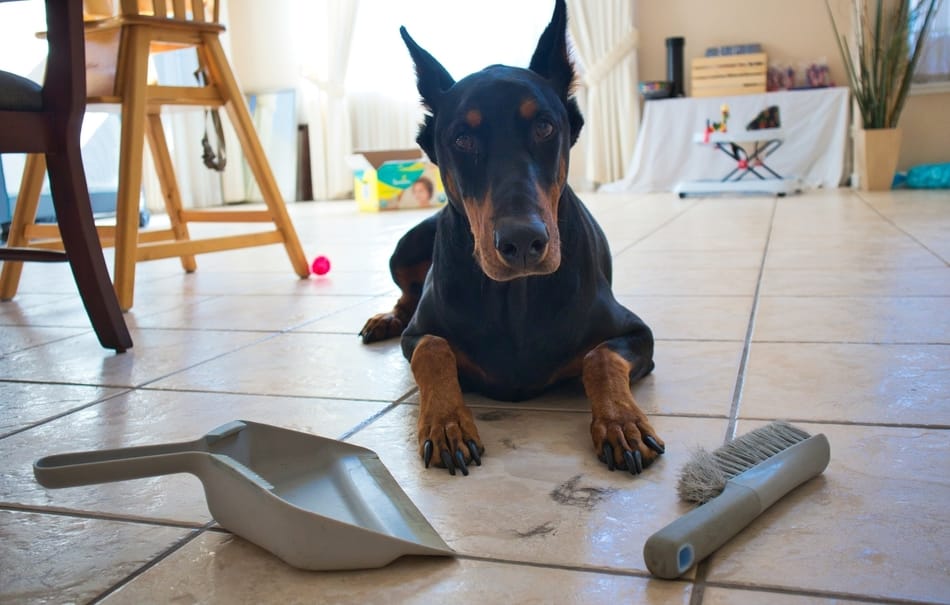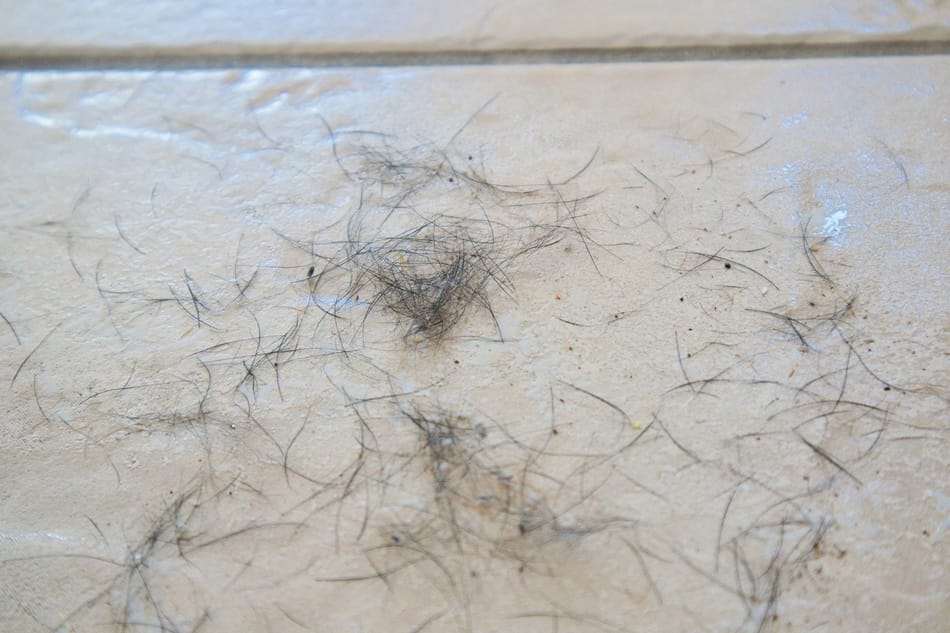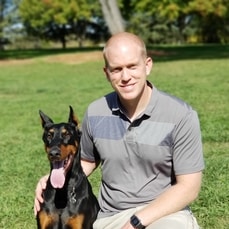
I was at the dog park recently with my Doberman and I ran into a woman who told me she absolutely loved my dog and the Doberman breed in general. She was excited about the breed because she thought they would be light shedders. She asked me, “Is that true?” Well yes, but there are some important differences in a Doberman’s coat and the coat of your average dog that you should be aware of.
How much do Dobermans shed? Dobermans shed low to moderate amounts year round, with very little seasonality to their shedding. Their hair is short and thick so it doesn’t static cling to clothes like the hair of many other dog breeds do.
Owners of Dobermans, myself included, typically feel their dogs are low shedders when compared to other dogs they’ve owned. This isn’t only because they shed a smaller number of hairs from their body, it’s also because the type of hair they shed is much easier to deal with.
If you’re entirely new to the Doberman breed, you may want to have a look at the complete breed overview here, so you know what to expect.
How Bad the Shedding Really Is and What’s It Like
Dobermans do shed less than many other breeds. For example, they shed significantly less than a typical labrador. Labrador’s, and many other breeds have a two-layer coat whereas the Doberman Pinscher only has a single layer. Their level of shedding can be best compared to the level you’d expect from a Dalmatian.
Their hair is short, thick, and pointed. Some describe the hair as similar in appearance to eyelashes. When you have a floor that hasn’t been cleaned in a long time and a Doberman living in the house, it looks like lots of eyelashes all over the floor.
Don’t get me wrong, I’ll still give my Dobie Cooper a semi-frustrated glare from time to time when I see a small pile of his hair. But really it’s not all that bad (no big clumps of hair), pretty rare, and very easy to quickly clean up.
There was a recent poll of Doberman owners regarding their dog’s shedding put on by iheartdogs.com. The results were that 57% of owners said they consider their Doberman to be low shedding while 34% said moderate shedding (and 9% reported no shedding).
Here are some of the best descriptions I can give about what the shedding is like from my 5-year-old, black colored Doberman:
- On the Floor: You can see the black hairs on the floor, but only on the tile. On the tile, you might get the occasional clump of hair, but it takes a while to build to that (a few weeks of not cleaning the floors). On carpets, it’s very difficult to see the hair since it’s so short and dark. If your carpet has any kind of speckling pattern or dark colors, then you really won’t be able to see the hair at all.
- Static Cling to Clothes: Personally, shedding bothers me most when it’s always stuck to my clothes. Which is one reason I love the Doberman. The short, thick fur is not as affected by static as a breed with finer hair would be. It just doesn’t stick to your clothes like that. Side note: Since the hair is semi-pointy and stiff, it can “stick into” the fabric of your clothes but you pretty much need to physically rub against your dog to make this happen.
- On the Couch, Curtains, or Other Upholstery: Although the hair won’t easily stick to fabrics in the house because of static, it will work its way in by the tip. The hair is stiff, short, and pointy at times. So it can hook into couch fabric or your bed comforter and be difficult to remove.
- On Your Hand When Petting the Dog: This is not an issue with Dobermans (unless your hand is wet). Pet your pooch all you want! The short thick hair won’t stick to your hand.
- Allergies: Allergy sufferers will be happy to know that Dobermans are really quite easy on the sinuses. Their coats are easy on the nose. The main way people have reactions to Dobermans is with skin reactions. The short pointy fir can sometimes cause people with sensitive skin to have a reaction. You can read my in-depth article about how hypoallergenic Dobermans are here.
- On the Skin: Some Doberman owners report that the short, thick, eyelash-like hairs of these dogs will stick them in their foot almost like a very fine splinter when they walk around the house barefooted. No one in my family (including my 1-year-old with very sensitive skin) has ever experienced this with our dog. But since some owners say it’s possible, I thought I would mention it.
Seasonally, these dogs shed pretty much the same amount year-round. This is especially true if your dog is primarily an inside dog. If he or she spends significant time outdoors, you might see a slight increase in shedding during the springtime as they lose their winter coat.
In general, Dobermans are very low maintenance dogs when it comes to their coats. They just don’t shed much and the little they do is manageable. Their short coat has other benefits like the fact that it doesn’t easily hold onto dirt or debris. That’s one reason Dobermans are not considered smelly dogs. Most say you only need to bathe your Doberman every few months (with wet cloth wipe downs in between bathings, about once a week).
TIP:
Although each individual dog can be different, blue or fawn colored Dobermans have less hair and therefore tend to shed less than black or tan Dobermans.
How to Reduce the Shedding
Although it’s clear these dogs are great when it comes to low shedding, there are still some things you can do to help reduce the shedding of your Doberman even further. After speaking with many owners of these wonderful dogs, I put together this list of the best tips for reducing shedding in Dobermans.
Best Methods for Reduce Doberman Shedding
- Regular Brushing. Brushing your dog’s hair outdoors once a week with a stiff bristle brush, rubber grooming tool, or grooming mitt will help remove the dead hairs and keep shedding to a minimum in your house. It will also give your dog’s coat a nice shiny appearance by distributing the dog’s natural skin oils and improving circulation.
- Wipe the Dog’s Coat with a Wet Cloth. Once a week, wipe down your dog’s coat with a wet cloth to help remove dead hairs.
- Use Oatmeal Bathing Shampoos. When you bathe your dog, use an oatmeal bathing shampoo. This also improves the health of their skin.
- Plenty of Excercise. Dobermans need lots of exercise for many reasons but one benefit is it will help circulation and improve their coat. I compiled a list of some great Doberman exercises here.
- Add a Teaspoon of Olive Oil to Meals. Believe it or not, simply adding just a teaspoon of olive oil to your dog’s meals with provide them with extra Omega-3 and Omega-6 fatty acids and improve their coat.
These are the best ways that I have found to reduce shedding in a Doberman. Although frankly, these steps aren’t always necessary since they really don’t shed all that much to begin with. But it’s always good to have a healthy, happy Doberman who has a beautiful shiny coat and gets plenty of exercise.
You can find a list of the products I use for Doberman hygiene here, many of these products took me years to find but are perfect for shedding Dobies.
It’s very important that you bathe your Doberman correctly since bathing is a little different for this breed. For a step-by-step guide on how to do this, see How to Bathe a Doberman: Bathing Schedule and Guide.

Dealing with Shedding in the House
Simply vacuuming every now and then in your house will be enough to take care of most of the shedding. However, there are some special techniques for taking care of these unique hairs when they work their way into other areas.
Since these are pointy, short, thick hairs they do work their way into fabrics around your house. This is especially true of fabric couches (if you have a leather couch, you won’t have this issue). If you simple vacuum your couch once over, you will see that it really didn’t pick up many of the hairs.
The reason is that these pointy little hairs stick between the threads of the fabric and “hook” themselves in. To get Doberman hair out of fabric it’s best to use a vacuum attachment that has bristles on the end. Then you’ll want to go back and forth at least two or three times over each spot, to loosen the hairs from the fabric. The sucking power of the vacuum isn’t enough for these hairs, you’ll need to work them loose also. A lint roller rolled over the couch can also grab the hairs enough to pull them out.
For the tile or hardwood floors, usually a quick vacuuming or sweeping is enough. If you live in an apartment or other small area with your Doberman, then this shouldn’t take you more than a few minutes.
If you see an area that is hard to get to with a broom or vacuum, just wet a paper towel and wipe the area. All the hair will easily stick to it so it can be discarded. We do this in our house in between vacuumings in areas that seem to collect the hair worse, like in front of the stairs, or on the sides of the frequently used hallway.
Spotting Abnormal Shedding
Your Doberman might be experiencing abnormal shedding if you are seeing un-even hair loss. This means patches of thinning areas of their coat. This can happen with Dobermans in their neck, chest, or stomach areas.
If you see hair loss that seems to be associated with a fever, skin irritation, or redness, then this is also abnormal. Also, if your dog is licking or scratching the area where this hair loss is occurring it may also indicate a problem.
If you see any of these signs of abnormal hair loss in your dog, make sure you take your dog to a veterinarian. Dobermans can be prone to serious thyroid and other issues that can first show themselves in the form of abnormal hair loss.
Early detection is key to being able to manage many of the health issues Dobermans are prone to. That’s why I always urge all Doberman owners to make sure they DNA health test their dogs so they know exactly what genetic issues might crop up later in life. Take a look at this Doberman DNA health testing guide I wrote to help make testing your dog really easy.
Related Questions
Does olive oil reduce shedding in Dobermans? Olive oil is rich in Omega-3 and Omega-6 fatty acids, both of which are important for healthy skin in Dobermans. Providing one-half teaspoon for every 10 pounds your dog weighs, once a day will help to reduce shedding by ensuring your dog has adequate nutrients to maintain a healthy coat.
Does coconut oil reduce shedding in Dobermans? Among many other health benefits, adding a teaspoon of coconut oil to your Doberman’s food every day can improve the health of their skin and coat while reducing shedding.



Hello John
Congratulations for the web page and for the youtube chanel.
I understand that the Doberman does not shed much but I want to ask you if they have the specific smell of large dogs such as the German Shepherd.
Thank you very much!
I’m not sure of the smell that you’re referring to. They do have a smell when they come in from being out in the hot sun for a while but that passes quickly. They also have a bit of a “wet dog smell” when they get wet but it isn’t bad and also passes quickly since they have such a small amount of fur as compared to many other breeds. Hopefully this answered your question.
I have a female Doberman whom turned 1 year on August 3rd. I have walked her every single day since the day I picked her up from the breeder on November 12/18.
We (Lucy) and I are averaging 6kms a day unless weather is uncooperative. In your professional opinion, is this to much exercise per day or might it be increased ?
The minute we’re back in doors, she lays flat out on the cool tiled floor for like 10 minutes before a large drink of water. Lucy currently weighs 65-67 lbs as of last week. I am Raising her in a Penthouse and she is by far the best trained dog in the building. I’m retired so I’m with her 24/7 and have NOT HAD one minute to myself since November 12/18 because I don’t have anyone I trust in being able to handle her. She’s a real gentle girl but loves to play & s ampler. Not a growl or sneer yet. I’m just concerned about the volume of exercise. She “heels” perfect, sits perfect, lies down perfectly and I have NOT allowed her to chase ducks, geese, birds, squirrels .
She heels perfect when walking by animals and Lucy is very socialized from walking & meeting other dogs. In fact she loves the elevator (13 floors) & she knows her place the minute the elevator doors open.
Generally, you don’t want to put a Doberman through strenuous exercise until they’re at least 18 months of age (2 years is better). The reason is that their bones are still developing and repetitive and intensive impacts on the joints can cause damage and issues with how they form. Now, of course this depends on how strenuous the walks are (a slow stroll, or a power walk/run) and it depends heavily on the type of ground you’re walking on. Walking on concrete is much harder on her developing joints than dirt or grass. I would talk to a veterinarian to make sure that what you want to do with her is ok. Good luck! Glad to hear she’s doing so well with training, that’s great!